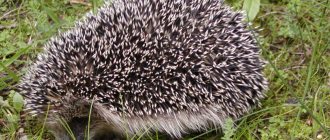The llama is an amazing animal that was domesticated several centuries ago. Today, unusual mammals are just as popular, they are used as beasts of burden, and are also raised on farms to produce high-quality wool and meat. These are hardy and unpretentious workers who can live both on the plains and in the highlands.
Llamas are recognized as the largest mammals in South America, which have survived to this day practically unchanged.
Origin of the species and description
Llamas prefer to live in mountainous areas.
The animal belongs to the camel family.
Scientists classify him as a separate genus of lamas. It is believed that the relatives of the beast are deer. The first llamas appeared in North America about 40 million years ago. After living on these lands for a certain amount of time, they began to migrate. This is how they ended up in South America, and later came to Europe. Interesting fact : crossing llamas with other animals is impossible, but as an experiment, scientists artificially mated them with dromedary camels, obtaining a single offspring from two species.
Since llamas are mountain animals, they settle near higher elevations. Unlike camels, they are not suitable for hot climates and deserts. The study of ancient civilizations has shown that the Indians of Peru kept llamas as livestock approximately 6 thousand years ago. They were used to transport heavy loads.
Fearless opponent
It turns out that llamas can be incredibly brave, brave and fearless in the face of predators. However, multiple attackers or a larger animal such as a mountain lion or wolf cause llamas to become vigilant and sound the general alarm. From time to time, ranchers tell stories of noisy night battles, and of the trampled bodies of coyotes, wolves and even small bears discovered in the morning in the llama pen. Amazing courage!
Llamas make good guard animals. Farmers often use them to guard herds of small animals such as sheep, goats and even alpacas. Always on the alert, these protectors are usually friendly towards their charges. Sometimes they even "adopt" smaller livestock into their personal herd.
Appearance and features
Close-up of a llama's head.
Llamas have similar external features to camels and deer. However, they lack a hump and horns. The body of the animal is rounded, due to its short limbs it is located at a low height.
Males grow larger than females, so they are easy to distinguish from each other. Males are used to carry loads. Females are exploited for breeding and as a stable source of fur.
Interesting fact : llamas can carry up to 50 kg at a time, but in most cases they are only half loaded so as not to subject the body to heavy stress.
The llama's head is elongated and shaped like a camel's. The ears stick out upward and have a sharp end. The animal's eyes are round in shape with black pupils. Thick eyelashes are located on the upper eyelids. The mouth has only lateral teeth, the front ones are absent. The animal picks up food with its lips and then chews it. The head is supported by a long thin neck.
Llama hoof close up
The animal's limbs are short, with cloven hooves at the end. So that the llama can move freely on rocky surfaces, the latter have massive calluses. The animal's tail grows up to 35 cm.
The entire body of the animal is covered with thick fur, which protects it from strong winds and frosts. The color of llamas is white or brown with different shades. The hair on the head of the animal is much longer than on the rest of the body.
Range, habitats
Habitat of the llama
Llamas appeared in the Andean mountains located in South America. Local residents quickly began to domesticate them and turn them into livestock. Because of this, wild individuals quickly disappeared, and at the moment all llamas existing on the planet are domesticated. People use males as cargo transport, and females are sheared twice a year to collect wool.
Interesting fact : during shearing, about a kilogram of wool is collected from one individual. The latter is used in the production of clothing.
Llamas in natural habitat
Now llamas are grown in North America, Australia, and Europe. The animal feels most comfortable in mountainous areas. It has also taken root well in Peru and Bolivia, since in these territories there are many places with short grass and shrubs, which are actively used for food.
You can meet llamas in Argentina, Ecuador and Chile in areas where there are mountains. It is believed that the animal was brought to these territories from North America.
What does it eat?
Lama eats only plant foods
Llamas eat exclusively plant foods, and have a rather narrow diet. They are able to feed on cereals, lichens, shrubs, parastephya and baccharis. These plants contain a large amount of minerals and useful elements that tone the animal’s body and allow it to carry loads for a long time.
Interesting fact : llamas eat about 2-3 kg of grass every day, which is 8-10 times less than horses. This is an added advantage to keeping them as livestock.
Llamas drink little water (2-3 liters per day) because the food they eat contains enough liquid so that the body does not experience symptoms of dehydration. A special treat for the animal are carrots, oranges, cabbage and other juicy fruits and vegetables. Lamas also don’t mind tasting bread.
Young individuals try to eat food that contains a lot of liquid and nutrients. This allows them to grow quickly and strengthen the body. Pregnant females may have a certain diet, and with the help of food they try to replenish the supply of missing vitamins.
The animal has a three-chamber stomach, thanks to which it digests even solid food. The pickiness of llamas when it comes to food helps people keep them without much expense. Individuals are regularly taken out for walks, where they eat grass and walk around the surrounding area.
Food
Llamas are very unpretentious in their diet. They eat shrubs, lichens, evergreen parastephya, cereals and other similar plants. Living in arid regions, animals replenish water reserves at the expense of plants.
Among their delicacies: broccoli, white cabbage, carrots and lade oranges. They also like to be treated to bread.
In general, they are not very gluttonous; in a day they consume eight times less food than a horse.
Closest relatives of the llama
Vicuna is a relative of the llama.
Relatives of llamas include the vicuna, an animal living in Chile, Peru, Argentina and Bolivia. The animal is similar in appearance to a llama, but has a thinner neck, and its hind limbs are significantly longer than its front ones. The animal grows up to 160 cm in length, and its weight does not exceed 50 kg. The main feature of the vicuña is the presence of lower incisors, which wear down and grow throughout life.
Also, llamas are related to camels, since they belong to the same family. The species have similar head shape and body structure. The main differences between them are the presence of humps in camels and thick fur in llamas.
Interesting: Squirrel











